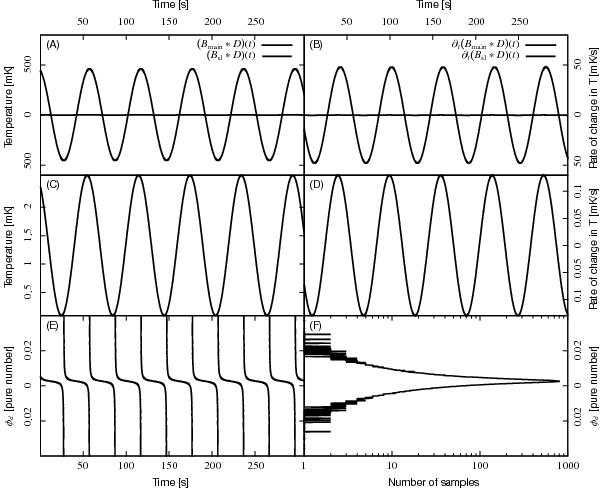Fig. 3

Results of a simulation which shows how φD is computed. We assume to observe a 1 K peak-to-peak dipole in the sky for 5 minutes with a scanning strategy very similar to the one used for Planck’s 30 GHz radiometers, i.e., the sky is scanned in circles of high amplitude (~85°) with a rotation frequency ν = 1 / 60 Hz and a sampling frequency of 32.5 Hz (so that 10 000 temperature samples are generated for each data stream). We observe the dipole using a realistic 30 GHz beam B = Bmain + Bside with FWHM ![]() . Panel A): plot of the (Bmain ∗ D)(t) term, which oscillates as a sinusoid with amplitude ≲ 0.5 K; the term (Bsl ∗ D)(t) is negligible (see panel C for a close-up). Panel B): plot of the ∂t(Bmain ∗ D)(t) term, used in the definition of φD (Eq. (9)). Panel C): Close-up of the (Bsl ∗ D)(t) term shown in panel A). Panel D): close-up of the ∂t(Bsl ∗ D)(t) shown in panel B). Panel E): value of φD as a function of time, calculated using the definition in Eq. 9. Panel F): distribution of the 10 000 values of φD plotted in panel E). Half of the values fall within the 0.19–0.34% range.
. Panel A): plot of the (Bmain ∗ D)(t) term, which oscillates as a sinusoid with amplitude ≲ 0.5 K; the term (Bsl ∗ D)(t) is negligible (see panel C for a close-up). Panel B): plot of the ∂t(Bmain ∗ D)(t) term, used in the definition of φD (Eq. (9)). Panel C): Close-up of the (Bsl ∗ D)(t) term shown in panel A). Panel D): close-up of the ∂t(Bsl ∗ D)(t) shown in panel B). Panel E): value of φD as a function of time, calculated using the definition in Eq. 9. Panel F): distribution of the 10 000 values of φD plotted in panel E). Half of the values fall within the 0.19–0.34% range.
Current usage metrics show cumulative count of Article Views (full-text article views including HTML views, PDF and ePub downloads, according to the available data) and Abstracts Views on Vision4Press platform.
Data correspond to usage on the plateform after 2015. The current usage metrics is available 48-96 hours after online publication and is updated daily on week days.
Initial download of the metrics may take a while.


